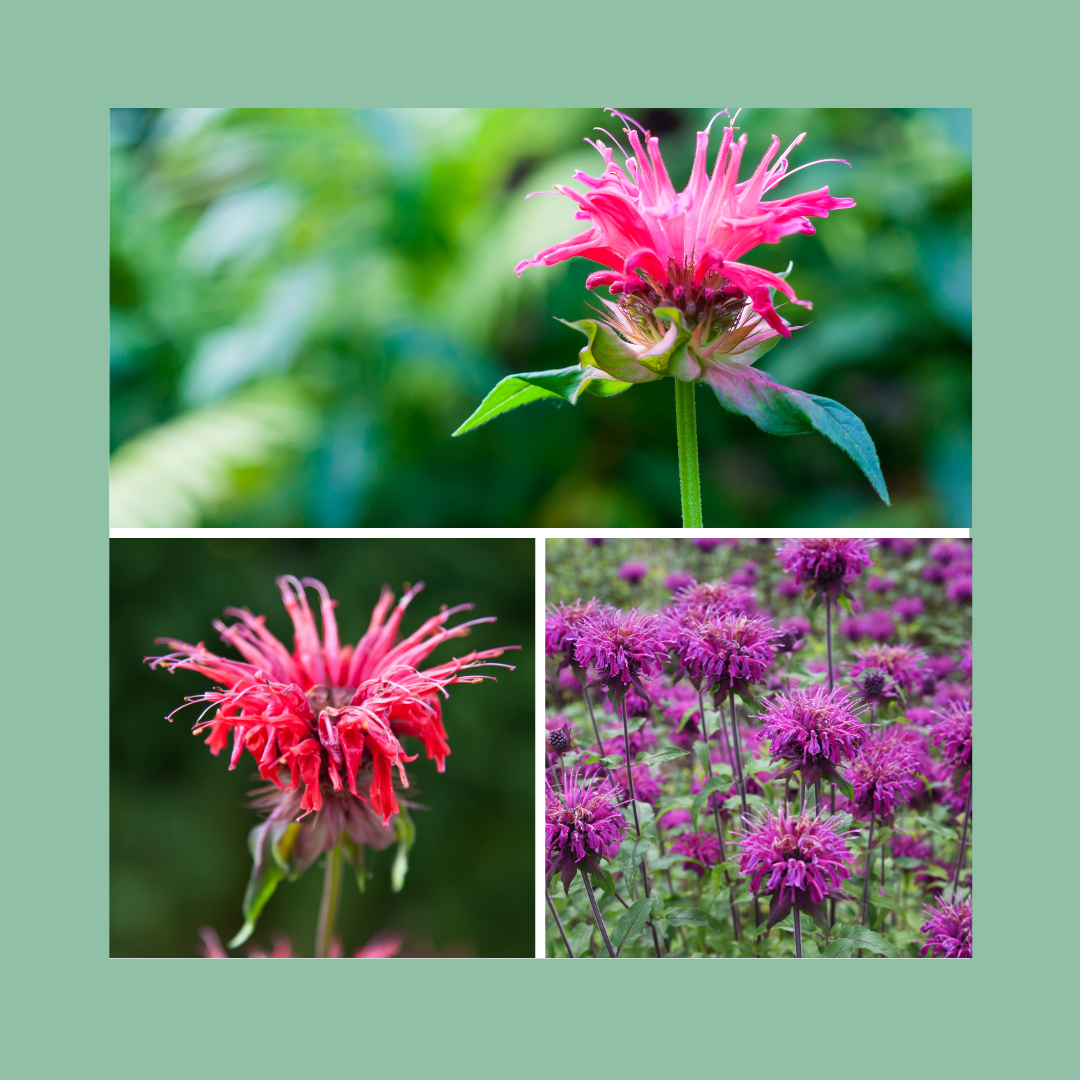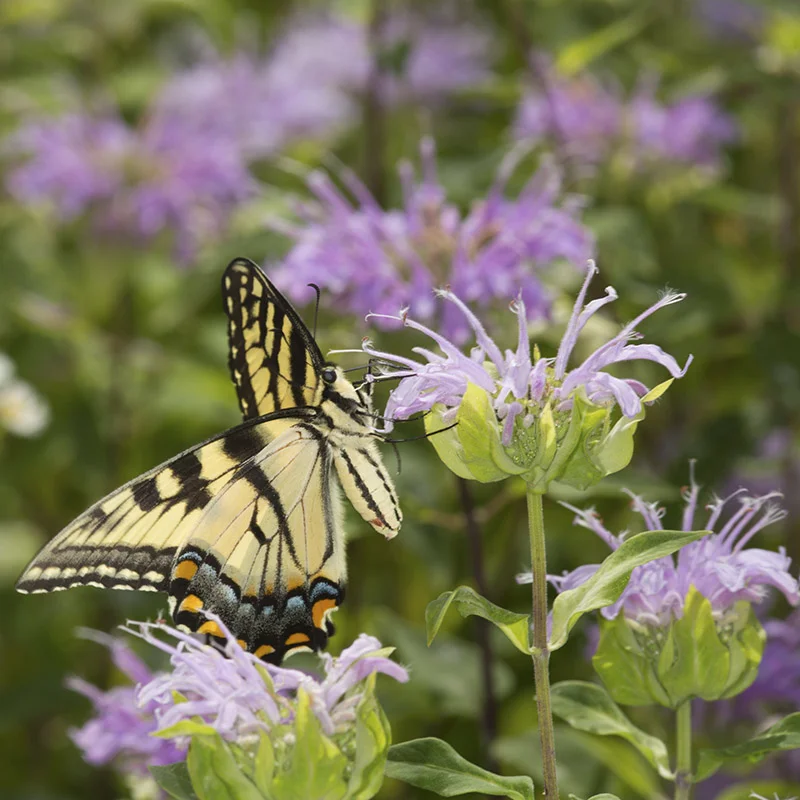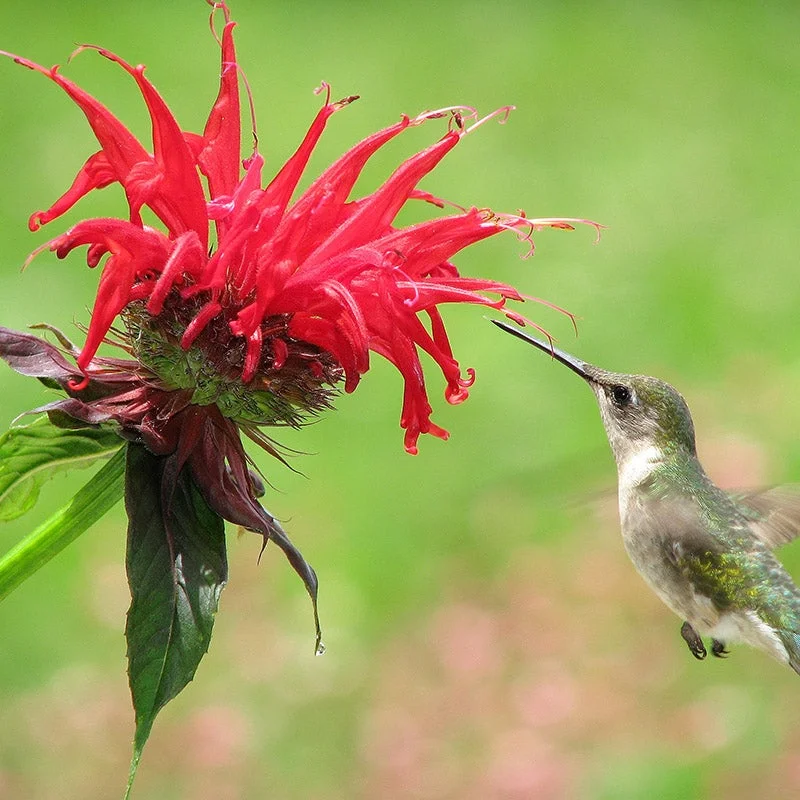

Wild Bergamot (Monarda fistulosa)
Image Credit: American Meadows
Height: 24 – 48″ tall
The Native Americans made healing teas from Monarda.
“After the Boston Tea Party in 1773, when American colonists dumped tea shipped by the British East India Company, in protest against British rule, the bergamot tea of the Oswego Indians became a popular substitute.” The Complete Illustrated Book of Herbs
Bee balm – A Native American remedy
“Monarda fistulosa is a beautiful wildflower native throughout North America. Its pinkish lavender blooms look like little fireworks, which helps remind one to look for it in bloom around the Fourth of July.” Acorn School of Herbal Medicine

Bee Balm ‘Jacob Cline’ (Monarda didyma)
Image Credit: American Meadows
Height: 36-48″ tall
Being native to North America, Monarda was well known by many different Native American tribes who all used it for similar conditions including fevers, coughs, congestion, infection, insect and venomous bites, and also as a food preservative and flavoring for meats. The red flowering bee balm, M. didyma, was part of a blend of native plants that were made into “Liberty Tea” that colonists drank in protest of the teas from England after the Boston Tea Party. M. fistulosa, the purple flowering variety gets the name “wild bergamot” from its similar fragrance to bergamot citrus tree (Citrus bergamia). M. fistulosa was used traditionally to induce a sweat during Native American sweat lodge ceremonies.” Acorn School of Herbal Medicine
Medicinal Use
To make herbal tea with fresh herbs, you will need an infuser

Norpro Stainless Steel 2-Inch Mesh Tea Infuser Ball with Teapot Weight
Image Credit: Amazon
Ingredients Needed:
- 1 cup water
- 3-4 fresh picked or dried bee balm leaves (or use as many as you like for desired flavor)
- 4-5 bee balm flower petals (optional) getbusygardening.com
“[Monarda fistulosa’s East” coast cousin Monarda didyma is also medicinal but has red flowers, and this species is the original Oswego tea referring to the Oswego Native Americans who inhabited the area which is now New York. M. fistulosa has a spicier flavor whereas M. didyma is sweet and mild, but both possess similar medicinal properties. Monarda fistulosa is one of the most important herbs used by Native Americans both historically and today.
“Monarda fistulosa is an aromatic, showy perennial plant that grows in clusters making the appearance of a bush. The plants are typically up to 2-3 feet tall with slender spreading rhizome roots. When you rub its leaves it smells of fragrant oregano. The flowers range from pale to bright pinkish-lavender and attract hummingbirds and bees. In the early morning light before dawn in the mountains of Colorado, I once found large bumblebees sleeping underneath the Monarda flowers tucked into the bottom petals. It grows in rich, moist but well drained soils, in fields, clearings, prairies, and mountain sides. It flowers from June to September, earlier for higher altitudes.
“Monarda is used internally for indigestion, intestinal cramps, nausea, flatulence, fevers, influenza, colds, bronchitis, whooping cough, sore throats, chronic and systemic candida infections, urinary tract infections, nerve tonic, and general relaxant. According to Sharol Tilgner, “It is beneficial for low-grade continual fevers with septic conditions, especially when related to viral infections.” It is also specific for lung infections. Monarda tea should be served hot to alleviate lung congestion. It can also be inhaled as a steam. (There are recipes down below with instructions on how to do this.) Topically it is used as a gargle for sore throats; its spicy nature can have an analgesic effect and a strong infusion helps to combat bacteria responsible and alleviates discomfort. It can also be used as a poultice for burns, wounds and rheumatic pains.
“Monarda is a well-known and still widely used plant among Native American healers, but is seldom used in Western herbalism today. As a member of the mint family it is very aromatic and the leaves smell of oregano. Native Americans inhaled the steam of the upper parts of Monarda to treat coughs, fevers and lung congestion. Monarda is specific for fever, lung congestion and cool, clammy skin.
“This is an excerpt from Culturally Important Plants of the Lakota, by Linda S. Black Elk
Monarda fistulosa
heȟáka tȟapȟéžuta, heȟáka tȟawóte, waȟpé waštémna
“‘The leaves are used to make a refreshing tea. The leaves are also edible raw or cooked. They have a very strong scent and flavor. [My own addition here is that Monarda is much like basil or oregano, and can make a nice addition to pesto]. An infusion of the flowers or leaves is used to treat abdominal pains, indigestion, fevers, sore throats, colds, whooping cough, and fainting. A poultice of the leaves is used to treat snakebites, to stop bleeding, to relieve sore eyes, and to prevent wounds from getting infected. The leaves are chewed while singing, dancing or hunting to prevent sore throat. A decoction of the whole plant is used to bathe diabetic ulcers – this will kill the infection and promote healing. The name “hehaka tapejuta” or “elk medicine” refers to this plant’s use as a love charm.'” Acorn School of Herbal Medicine
Harvesting
“Monarda should be harvested while the flowers are in peak bloom, from July to August. The leaves and flowers can be prepared into tinctures, vinegars, honeys, oxymels, teas and steam inhalations from the fresh plant. It can be dried and stored for teas, which still retains a high concentration of volatile oils. Harvest about 2-3 nodes down from the flower head, right above a pair of opposite leaves that still look green and fresh. All mints will send up two new shoots when you pick the main stem of the plant. Harvesting right above the node ensures the plant can send up more shoots which will bear flowers and help provide essential food for bees and other pollinators. There is no need to pull up the entire plant since the roots are not used, and being a perennial herb careful harvesting ensures more seasons of harvesting to come. Due to the high volatile oil content of Monarda, care must be taken when drying to make sure all plant material is completely dry before you store it. Bundle in groups of 4-5 stalks, hang upside down in a cool room with airflow. You can also lay them single layer on a drying screen or rack and flip them occasionally. Check by breaking a stem after 2-3 weeks. The stem should snap and not bend and the leaves should crumble easily. Store in glass jars in a cool, dark place. The dried plant has a shelf life of up to two years if properly stored.
Preparation & Dosage
Tea/Infusion
“With this plant a little bit goes a long way and teas tend to get quite spicy with even a small amount of Monarda. Start with 2 dried flower heads and some leaves. Crush and put in a 16 oz glass jar. Pour boiling water over, stir and cover with a tight fitting lid. Steep for 10 minutes. Strain and drink warm. It is especially important to serve the tea hot for its diaphoretic effects and when treating fever and chest congestion.
Tincture|
“Fresh or dried plant, take 10-30 drops added to a little water, 1-4 times per day.
Steam inhalation
“This method is very helpful in lung congestion and coughing. Can be done 3 times a day until improvement is seen. Fill a stock pot 1/3 full of water. Bring to a boil. Remove from heat, add 4-5 dried Monarda flower heads and a handful of leaves, stir and cover. Let it sit for 10 minutes. With caution, set the stock pot on a towel on a low table. Sit so that your head is above the top of the pot. Cover yourself and the stock pot with a blanket or sheet to form a tent. Carefully and slowly, using on oven mitt, open the lid a small crack and let some steam out. Do this very slowly and carefully because the steam will be very hot and can hurt your face. You just want to release enough steam to make it warm and misty under the covers. Close your eyes and inhale deeply into your lungs through your mouth. If it gets too spicy, cover the pot, and come out from under the covers and take a break. Try to inhale the steam for at least 5 minutes, or as long as you can tolerate.
Honey infused
“Pick fresh Monarda. Shake gently to oust any bugs. Let sit in the shade for 10-15 minutes to wilt. Chop coarsely with a sharp knife. Add plant material to a mason jar. Fill the jar 2/3 full. Pour good quality local honey over the chopped plant until it is completely submerged. Stir the honey and plant to ensure all of the plant material is well coated. Push all plant bits down under the honey and cover well. Keep in a warm place to infuse for about 4-6 weeks. Or if you need this remedy sooner, you can use a warm water bath to speed up the infusion process. To do this take the lid off the jar of Monarda-infused honey and place the jar in a pot with water on the stove (like a double boiler). Make sure the water line is well below the top of the jar to avoid getting water into the honey. Heat on low to medium heat for about 6 hours. Water should be hot and steaming but not boiling, and you will need to replace water as it evaporates. You can also use a crock pot to do this. Place the open jar in water in the crock pot and put it on high until the water gets warm and then put on low. Let steep for 6-8 hours. Once the honey is done, strain well and keep in a tightly sealed jar in a cool, dark place. Taken internally Monarda syrup is a wonderful sore throat remedy. You can also mix it in hot water and drink for coughs and congestion. Externally it can be a fabulous treatment for burns and wounds.” Acorn School of Herbal Medicine
Contraindications
“Avoid internal use while pregnant.
References
-
Bergner, Paul. Folk Remedies Database. Boulder: Bergner Communications, 2001.
-
Moore, Michael. Medicinal Plants of the Mountain West. Santa Fe: The Museum of New Mexico Press, 1979.
-
O’Brien, Mary and Karen Vail. Edible and Medicinal Plants of the Southern Rockies. Parker: Book Crafters, 2016.
-
Skenderi, Gazmend. Herbal Vade Mecum. Rutherford: Herbacy Press, 2003.
-
Tierra, Michael. Planetary Herbology. Twin Lakes: Lotus Press, 1992.
-
Tilgner, Dr. Sharol Marie. Herbal Medicine from the Heart of the Earth. Pleasant Hill: Wise Acres LLC, 2020.
-
https://theherbalacademy.com/benefits-of-bee-balm-monarda-fistulosa-and-m-didyma/
https://www.acornherbschool.com/plant-profiles